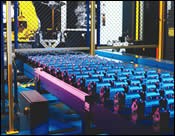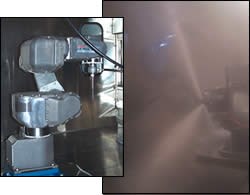Robots Make A Clean Sweep
A plant already effective at using robots for work handling applies robots to the end of the process as well, using them to clean and deburr intricate parts.
Share




Hwacheon Machinery America, Inc.
Featured Content
View More

Autodesk, Inc.
Featured Content
View More
ECi Software Solutions, Inc.
Featured Content
View More
Takumi USA
Featured Content
View More

Manufacturers of intricately machined components face special part cleaning challenges. Burrs, chips and debris in the tiny crevices can compromise cleanliness specs and compound labor expenses. Because robotics are often relegated to unload/load tasks, they may be overlooked as a means to address these problems. As one Escanaba, Michigan-based Tier 1 supplier to major diesel engine manufacturers demonstrates, using robots to adequately clean and deburr parts with cavities, cross-holes, deep, tapped holes or other internal features is a real and potentially effective possibility.
In fact, those struggling with the limitations of traditional cleaning and deburring measures can glean valuable insights from Engineered Machined Products, Inc. (EMP), which replaced a three-axis CNC-style wash system for which operational costs and lead times were high with an integrated robotic solution. The company developed its own customized cells, adding high-pressure, CNC-based cleaning and deburring capabilities to compact robots rated for harsh environments. In doing so, EMP notes that its operational costs are considerably lower while the valve bodies, manifolds, pumps and hydraulic components that the company machines are considerably cleaner. The success represented one more example of how this highly automated plant applies robots to multiply the value of its large workforce.
Automation And Innovation
Each day, more than 450 employees head to EMP’s 270,000 square-foot hub, which is situated in Michigan’s Upper Peninsula. With a landscape of highly integrated cells, including more than 200 CNC machines and 38 robots on the shop floor, EMP shows remarkable acumen in automation. The heavy user of Fanuc Robotics first dabbled in automation in 1998. Since then, automation has become a mainstay at the company. Four major cells include automated horizontal machining centers, robotic operations, work setting and work transfer stations, pallet shuttles, conveyor systems and multifunction operations.EMP also performs secondary operations such as ultrasonic cleaning, derusting, thermal deburring and demagnetizing parts. Given that many of the parts that EMP produces entail multiple machining and cleaning operations, the company uses both automation and innovation to gain efficiencies and reduce overall costs. The company is just as progressive with its strategy of developing solutions in-house as it is with integrating automation into its operations.
Robotic Reinforcements
Ongoing efforts to diversify brought about a project involving oil rails. From the get-go, because of both the size and the intricacy of the parts, it was apparent that an off-the-shelf solution might be expensive or problematic. The engineering staff at EMP instead set its sights on a robotic deburring solution, realizing that an application-specific approach would support its aims of reducing lead times, sustaining overall quality and minimizing costs. In addition, the approach jived with EMP’s strategy to combine stand-alone elements able to be redeployed for different uses later.Ultimately, the company decided to design an enclosure that could withstand high pressure water and incorporate a compact robot that would manipulate a lance nozzle spraying high pressure deionized water and rust inhibitor to clean and deburr machined components. The decision was made to introduce the components to the robot via a 400-mm pallet changer. Within a span of 8 months, in 2005, the first cell (prototype) was ready to go.
Using Pro-E 3D modelling software, Robert Stenfors, a senior tool design engineer at EMP, completed the overall design of the system. Mr. Stenfors spent a good deal of time on the design phase to ensure that the build phase of the system went smoothly. He also designed the high pressure rotary union and lance nozzle for the system, after most manufacturers of high pressure rotary unions said that they could not guarantee that their units would hold up to the harsh environment for longer than 1 month. The rotary union/lance nozzle has since been patented. Jim Franks, assembly engineer, designed the three-way valve on the system, used for shifting between high and low pressure water, using Pro-E software.
From The Ground Up
Just as the group was selective when determining the appropriate alternative to the CNC style washer, EMP was just as discriminating when choosing a robot. Prerequisites were 1) a machine that would be compact enough to squeeze into a small enclosure—roughly measuring 10 feet, 6 inches wide by 12 feet, 10 inches long—and 2) one that would offer a high IP rating. This rating would indicate that the robot would be sealed tight enough to withstand a harsh cleaning environment.What the company found was an LR Mate 200iB washdown robot. Part of Fanuc Robotics’ line of cleanroom robots, the LR Mate is a six-axis, AC servo-driven robot that is optimized for use in sensitive, contaminant-controlled environments. The stand-alone unit sprays water at 5,000 psi for medium and high production cleaning of aluminum and ductile iron. The compactness of the tabletop-sized robot also means that the company can package the entire system in a floorspace-efficient enclosure.
Prior to the LR Mate, part of the high operational costs of the CNC-style washer related to maintenance—perhaps because of the harsh, flaky burrs characteristic of ductile iron. The washdown robot system, by comparison, is fairly fuss-free.
“The mechanical portion is fine,” reports Michelle Denkins, automation engineer at EMP. “The nozzles must be replaced periodically, as do the filters. Other maintenance consists of greasing the robot now and then. We anticipate having to rebuild the pump eventually. However, the system that has been running for nearly 2 years has not yet necessitated having to rebuild the high-pressure pump.”
The LR Mate is not employed for primary cleaning. Rather, the cell in this enclosure represents the last stop during an elaborate cleaning sequence that involves various processes, the culmination of which is virtually burr-free parts ready to be dried, packed and dispersed among various customers. EMP’s goal is to make the robot the last stage—ideally removing all chips and any light burrs. Basically, its aim is to virtually eradicate manual removal altogether.
According to manufacturer Fanuc Robotics, the robot arrangement is particularly effective at expelling particulates because of its “continuous turn” feature, which allows rotating the nozzle infinitely in one direction by means of a joint on the robot. Able to operate as either a spinning nozzle or as directed, high-pressure spray, the nozzle can be rotated while it focuses on a certain part feature.
The success of the initial cell sparked EMP to build four other cleaning and deburring cells. Two of the five cells are devoted to hydraulic components, end caps and pump housings. Of the five machines on the floor, Mrs. Denkins has taught the paths for all of them. The brunt of programming was performed in RoboGuide HandlingPro, an offline simulation package offered by Fanuc Robotics, and the final teaching was done on the shop floor.
Mrs. Denkins ascribes the efficiency to the software’s CAD-to-path programming, simple robot teaching methods and collision detection feature.
Using the CAD-to-path programming, Mrs. Denkins can create robot paths for the cell from imported CAD data. Once she defines the process requirements on the CAD model, RoboGuide generates the robot program. The robot teaching features also allow her to program motions either by teaching positions on the part models or by entering robot coordinates manually. Using the collision detect feature, the operator can visually identify collisions during robot simulation. Thus, the robot, tooling and/or parts can be relocated before the system is built or the robot is put in place. Customarily, Mrs. Denkins says she sets the sensitivity a little higher when teaching points just to be safe and to avoid bending the lance nozzle.
Mrs. Denkins and Dennis Darling, controls/electrical engineer, educate operators about how each robotic cleaning system works and how to recover from robot faults, should those arise. These faults serve as a safeguard against damaging the equipment. An operator must be aware of when to change the filters, when to adjust the water pressure (low- or high-pressure alarms) and how to uphold consistency. All of these factors are indicated via alarms. For example, if a filter should clog or the lance nozzle should start to wear out, the resulting pressure fluctuation triggers an alarm. As a result, the system prevents a part from not being fully cleaned because of a drop in pressure, Mrs. Denkins explains.
Mr. Darling was responsible for the
electrical design of the system and the PLC and HMI programming. Safety
was a primary concern when designing the system, along with the
functionality of the machine. The high pressure water could be
dangerous if the proper safety controls were not instated. Mr. Darling
incorporated all of the alarm messages cited above and help screens on
the HMI for the operator to reference in the event that he/she is
unfamiliar with the HMI screens. Users can discern how to adjust for
areas that are more difficult to deburr. This means that the company
can revise machining strategies to eliminate a burr, if need be.
Impetus For Growth
In fact, this concept of “revising strategies” represents an enormous reason why EMP has embraced robots throughout the rest of its process as well. Now, no longer bound by the constraints of traditional cleaning equipment, EMP’s nimble cleaning technology benefits from the same flexibility as the rest of the plant—the freedom to reprogram and relocate automation resources as needed for the company to keep diversifying. Plus, there is the simple fact of the effectiveness of robots for cleaning, as Mrs. Denkins notes.“Millipore tests confirm that the parts are cleaner than parts washed with the CNC equipment,” she concludes.
Related Content
4 Steps to a Cobot Culture: How Thyssenkrupp Bilstein Has Answered Staffing Shortages With Economical Automation
Safe, economical automation using collaborative robots can transform a manufacturing facility and overcome staffing shortfalls, but it takes additional investment and a systemized approach to automation in order to realize this change.
Read MoreCutting Part Programming Times Through AI
CAM Assist cuts repetition from part programming — early users say it cuts tribal knowledge and could be a useful tool for training new programmers.
Read MoreInvesting in Automation, Five-Axis to Increase Production Capacity
To meet an increase in demand, this shop invested heavily in automation solutions and five-axis machines to ramp up its production capabilities.
Read MoreFour-Axis Horizontal Machining Doubles Shop’s Productivity
Horizontal four-axis machining enabled McKenzie CNC to cut operations and cycle times for its high-mix, high-repeat work — more than doubling its throughput.
Read MoreRead Next
Setting Up the Building Blocks for a Digital Factory
Woodward Inc. spent over a year developing an API to connect machines to its digital factory. Caron Engineering’s MiConnect has cut most of this process while also granting the shop greater access to machine information.
Read MoreRegistration Now Open for the Precision Machining Technology Show (PMTS) 2025
The precision machining industry’s premier event returns to Cleveland, OH, April 1-3.
Read MoreBuilding Out a Foundation for Student Machinists
Autodesk and Haas have teamed up to produce an introductory course for students that covers the basics of CAD, CAM and CNC while providing them with a portfolio part.
Read More





















































